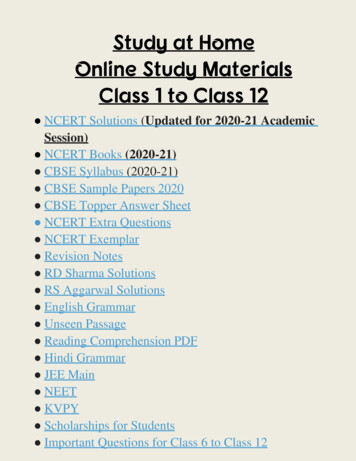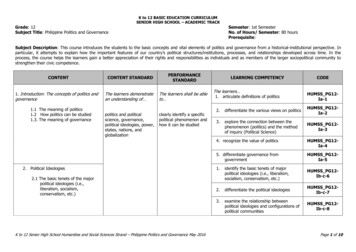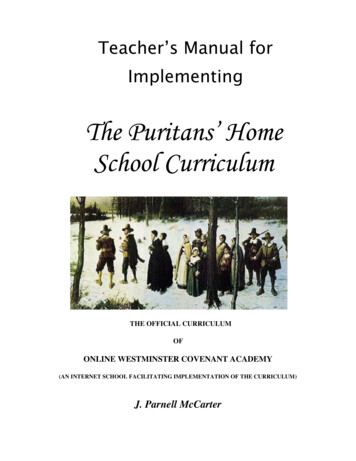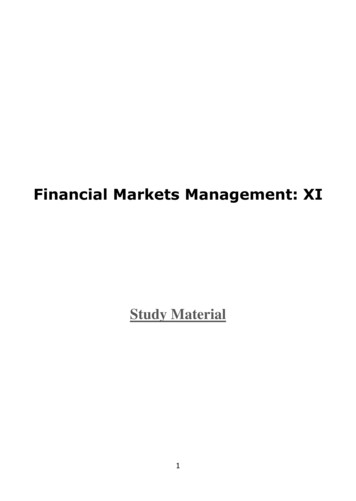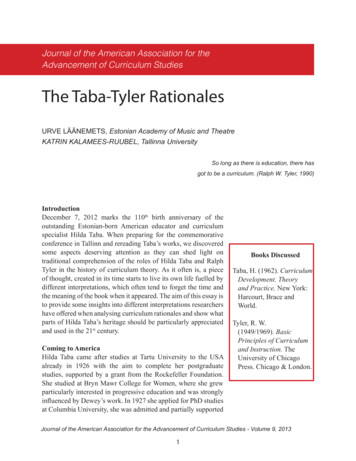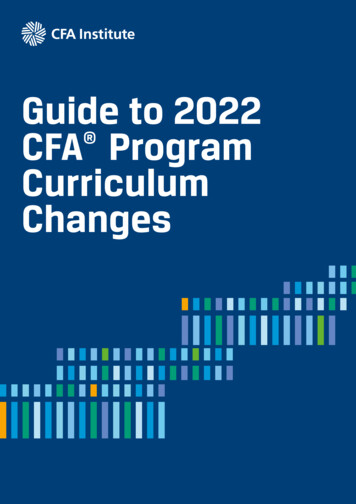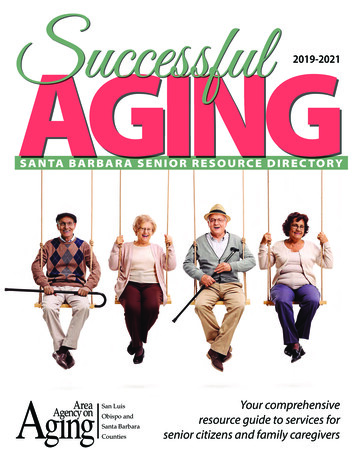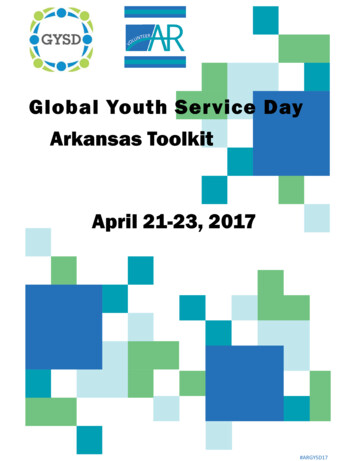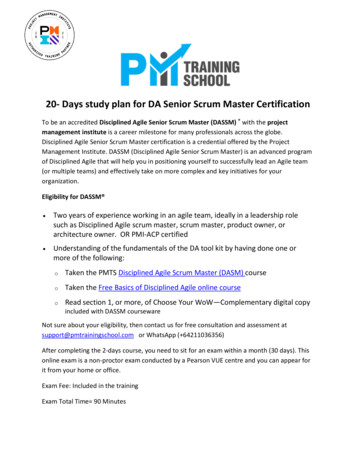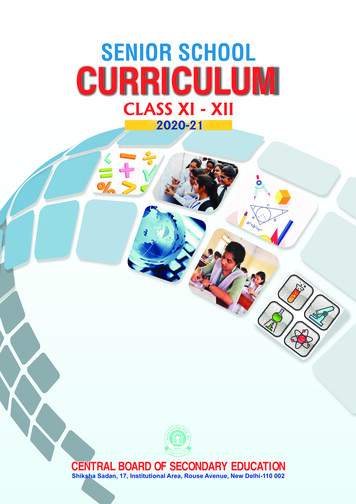
Transcription
SENIOR SCHOOLCURRICULUMCLASS XI - XII2020-21CENTRAL BOARD OF SECONDARY EDUCATIONShiksha Sadan, 17, Institutional Area, Rouse Avenue, New Delhi-110 002
1.PRINCIPLES OF THE CBSE CURRICULUMThe curriculum refers to the lessons and academic content to be taught toa learner in the school. In empirical terms, it may be regarded as the sumtotal of a planned set of educational experiences provided to a learner bya school. It encompasses general objectives of learning, courses of study,subject-wise instructional objectives and content, pedagogical practicesand assessment guidelines. The curriculum provided by CBSE is based onNational Curriculum Framework-2005 and seeks to provide opportunitiesfor students to achieve excellence in learning.1.1Salient Features of the CBSE Senior Secondary School CurriculumThe Curriculum prescribed by CBSE strives to:1.21.provide ample scope fordevelopment of students;physical,intellectualandsocial2.enlist general and specific teaching and assessment objectives;3.uphold Constitutional values such as Socialism, Secularism,Democracy, Republican Character, Justice, Liberty, Equality,Fraternity, Human Dignity of Individual and the Unity and integrityof the Nation by encouraging values-based learning activities;4.nurture Life-Skills by prescribing curricular and co-curricularactivities to help improve self-esteem, empathy towards differentcultures etc.;5.integrate innovations in pedagogy and assessment to keep pacewith the global trends in various disciplines;6.promote inclusive education by providing maximum possible equalopportunities to all students;7.integrate environmental education in various disciplines;8.equally emphasize Co-scholastic areas of General StudiesHealth and Physical Education.9.Promote Art integrating learning.andObjectives of the CurriculumThe Curriculum aims to:1.achieve desired national level of competencies in cognitive, affectiveand psychomotor domains;2.facilitate acquisition of 21st Century Skills and enhance self andsocial awareness through thematic or multidisciplinary approach;3.promote Cooperative Learning, Collaborative Learning, Self directedlearning etc. to facilitate realization of learning outcomes;4.promote Authentic Assessments based on real world tasks involvingmeaningful application of knowledge and skills;5.promote Life Skills , inculcate values , foster cultural learning andinternational understanding in an interdependent society;1
1.36.acquire the ability to utilize technology and information for thebetterment of humankind;7.strengthen knowledge and attitude related to livelihood skills andpromote lifelong learning;8.develop the ability to appreciate art and showcase talents;9.promote physical fitness, health and well-being Curriculum Areas at Senior Secondary LevelFor the purpose of fostering competences in learners, the curriculumencompasses seven major learning areas, which are: Languages, Humanities,Mathematics, Sciences, Skill Subjects, General Studies and Health and PhysicalEducation. These areas are broadly divided into Scholastic and Co-scholasticareas as detailed below:LanguagesScholastic AreasAcademic ElectivesSkill ElectivesGeneral StudiesHealth & Physical Education*Work ExperienceCo-scholastic Areas*Work experience is subsumed in Health and Physical Education1.3.1 Scholastic Areas:The curriculum envisages individualized personal learning acumen andseeks to explore the potential of students in acquiring substantialknowledge and skills through academic rigors. With greater academicorientation and research skills in core academic areas, students wouldevolve as discerning young adults with a sense of real self-esteem havingtrue values and principles. The scholastic areas are as follows:(i)Languages include Hindi, English and other 30 languages. Thecurricula in languages focus on listening, speaking, reading andwriting skills and to develop effective communicative proficiency.Learners use language to comprehend, acquire and communicateideas.(ii)Subjects like Geography, History, Economics, Home Science,Sociology, Fine Arts, Political Science, Fashion Studies, and relatedsubjects promote the learning of history and culture, geographicalenvironment, global institutions, constitutional values and norms,politics, economy, interpersonal and societal interactions, civicresponsibilities and the interplay of the above-mentioned learning.Learners appreciate and value every human's right to feel respectedand safe, and, in this regard, also understand their FundamentalRights and Duties and behave responsibly. Learners learn to betolerant and empathetic towards others through the study of thesesubjects.2
(iii) Subjects like Biology, Chemistry, Physics, Computer Science,Informatics Practices help in making students perceptive aboutmatter and energy, nature, the environment, technologybreakthrough in science. The focus is on knowledge and skills todevelop a scientific attitude and to use and apply such knowledgefor improving the quality of life. This learning can be used toanalyze and evaluate existing scenarios and propose innovativesolutions to situations. Learners understand and appreciate thephysical, biological and technological world and acquire theknowledge and develop attitude, skills and values to make rationaldecisions in relation to it.(iv) Mathematics includes acquiring the concepts related to numbers,operations, computation, measurement, geometry, probability andstatistics, the skill to calculate and organize and the ability to applythis knowledge and acquired skills in their daily life. It also includesunderstanding of the principles of reasoning and problem solving.Learners identify, integrate and apply numerical and spatialconcepts and techniques. They have clarity of concepts and are ableto connect them to the real world. Learners rationalize and reasonabout pre-defined arrangements, norms and relationships in order tocomprehend, decode, validate and develop relevant patterns.(v)Subjects like Business Studies, Accountancy, Entrepreneurship,Economics and related subjects help in gaining understanding aboutcore business disciplines. They understand the concept like, theexchange of items of value or products between persons orcompanies and the meaning / relevance/ Significance of any suchexchange of money for a product, service, or information.(vi) Subjects like Dance, Drama, Music, Heritage Crafts, Fine Arts,Sculpture and related subjects aim to help learners cultivate aninterest and appreciation for arts and encourage them toenthusiastically participate in related activities, thus, promotingabilities such as imagination, creativity, value arts, and the culturalheritage.(vii) Skill Electives help in development of professional competencies,which are analytical, applied and outcome based. Undergoing skillstraining in schools can help students learn about a tradeprogressively to create a product and also to become a problemsolver in real life. At present many Skill electives are beingoffered by the Board in the fields of Hospitality and Tourism,emerging technology like Artificial Intelligence, GeospatialTechnology, Finance, Business, Retail & Insurance etc. Studentscan also choose subject from diverse areas such as Fashion Design,Agriculture, Banking, Mass-Media Healthcare and many more.1.3.2 Co- Scholastic Areas:Co-curricular activities aim at development and using knowledge and skillsin different fields to groom the overall personality and character of3
students. It includes Health and Physical Education including WorkEducation and SEWA, various Creative Arts like Painting, Crafts, Danceand Music, and social activities. Instead of co-curricular activities, theterm co- scholastic activities is used as both cognitive and non-cognitivedevelopment can take place by exposing the child to the lesson onscholastic subjects and non-scholastic subjects. General Studies, Healthand Physical Education (Work Education has been subsumed) , Yoga,traditional games, indigenous sports, NCC, Scouts and Guides, Martial Artsetc. are integral part of the curriculum and would be in the routine of theschools for the holistic development of children as per the specific detailsgiven below:Health and Physical Education focuses on holistic development, bothmental and physical, understanding the importance of physical fitness,health, well-being and the factors that contribute to them. Focus of thisarea is on helping learners develop a positive attitude and commitment tolifelong, healthy active living and the capacity to live satisfying,productive lives with the help of health management, indigenous sports,yoga, NCC, self-defense, fitness and lifestyle choices.These learning areas are to be integrated with each other in terms ofknowledge, skills (life and livelihood), comprehension, values andattitudes. Learners should get opportunities to think laterally, critically,identify opportunity, challenge their potential and be open to challenges.Learners value and engage in practices that promote physical, cognitive,emotional and social development and wellbeing. This enables learners toconnect different areas of knowledge, application and values with theirown lives and the world around them. The holistic nature of humanlearning and knowledge should be brought forth throughout.General Studies: The purpose of orienting students to General Studies isto develop in them an appreciation for the holistic nature of knowledge.In contemporary times, familiarity with General Studies is indispensablebecause at the senior school stage there is an element of specializationdue to which the students do not get exposed to some vitaldisciplines/areas of study that are not covered in their specialized field.The whole course of General Studies is, therefore, focused on properdevelopment of the ‘affective domain’ by exposing the students to varieddomains of study.The documents with details of Health and Physical Education and GeneralStudies are available on www.cbseacademic.nic.in2.IMPLEMENTATION OF CURRICULUM2.1School Curriculum CommitteeThe Board mandates that all schools must setup a School CurriculumCommittee with teachers representing each areas. The School CurriculumCommittee would define activities for pedagogical practices, evolve aplan of assessment and mechanism of feedback and reflection and ensureits implementation. The committee would also ensure that the textbooks/4
reference materials are age appropriate, incorporate inclusive principles,are gender sensitive, have valid content and do not contain any materialwhich may hurt the sentiments of any community. The committee willthen send the list of books to the Principal to take action as per para2.4.7 (b) of the Affiliation Byelaws, 2018.The committee would alsoensure that the reference materials reflect conformity with theunderlying principles of the Constitution of India and are compliant withNCF-2005.Issues of gender, social, cultural and regional disparities mustbe taken care of in the curriculum transaction.2.2Pedagogical Leadership:All Principals have a crucial role to play in the evolution of the teachinglearning ecosystem as the Head and pedagogical leader of their schools. Inthe role of school pedagogical leader, the Principal is expected toundertake the following:a)Lead, Guide and Support the teaching and learning processes in theschool by focusing on classroom specific requirements fortransacting the curriculum, so that both teachers and studentsperform at their optimal best.b)Direct the entire focus of all school activities towards the students’learning and acquiring of necessary competencies. Every activitytaken up by the school, therefore, should be mapped for theacademic competencies, and for life skills, values, etc., beingacquired by the students.c)Prepare Annual Pedagogical Plan of the school by designing anddeveloping annual plan for the school by giving equal importance toscholastic and co-scholastic areas.d)Promote innovative pedagogy, with special focus on integrating art,sports and ICT (Information and Communication Technology) witheducation, and use active and experiential learning methods in theclassrooms.e)Ensure joyful learning at all levels through use of such innovativepedagogy.f)Develop school specific resources for teaching and learning, in theform of lesson plans, e-content, use of mathematics and sciencekits developed by NCERT, etc.g)Ensure proper in-house training of teachers in the school to enablethem to unleash their own unique capabilities and creativity intheir classrooms.h)To be up to date with all new ideas and tools, etc. being used ineducation at the global level and constantly innovate the pedagogyof the school.i)To make efforts to learn from the best practices of other schools,by arranging for discussions with Principals of such schools, orthrough observation visits of teachers to other schools.5
As a pedagogical leader, the principal must prepare Annual PedagogicalPlan. The Board has not laid down the structure or format of the annualpedagogical plan as the Board respects academic autonomy of everyschool and expects each school to prepare its own unique and innovativeannual plan. This plan must be an implementable one with timelines thatshould include administrative inputs and detailed pedagogical aspects.2.3Pedagogical Practices by TeachersThe pedagogical practices should be learner centric. It is expected of ateacher to ensure an atmosphere for students to feel free to askquestions. They would promote active learning among students with afocus on reflections, connecting with the world around them, creatingand constructing knowledge. The role of a teacher should be that of afacilitator who would encourage collaborative learning and developmentof multiple skills through the generous use of resources via diverseapproaches for transacting the curriculum.Teachers should follow inclusive principles and not label children as ‘slowlearners’ or ‘bright students’, or ‘problem children’. They should insteadattend to the individual difference of students by diagnosing andmodifying their pedagogic planning. As far as possible, Arts should beintegrated in teaching, especially while teaching the concept whichstudents find difficult to understand.2.4Competency based Learning:To face the challenges of 21st Century, education should be competencybased and Principals as Pedagogical Leaders must create conduciveenvironment for development of competencies among the students.Competency based Learning focuses on the student’s demonstration ofdesired learning outcomes as central to the learning process. Learningoutcomes are statements of what is expected that the student will beable to do as a result of learning the activity. In a way learning outcomesare statements of what a learner is expected to know, understand and/orbe able to demonstrate after completion of a process of learning.Therefore, the focus is on measuring learning through attainment ofprescribed learning outcomes, rather than on measuring time.Experiential and active learning are the best pedagogies for CompetencyBased Learning. Experiential Learning will promote critical thinking,creativity and effective study skills among students. Learning Outcomesapproach developed by NCERT for classes I-X may be adopted by all theschools and teaching-learning process may be changed in the light ofthese outcomes. The schools are expected to have well-defined LearningOutcomes for every grade that are observable and measurable, andempower learners to focus on mastery of valuable skills and knowledgethrough these Learning Outcomes, deemed to be essential for success inlife. It is expected that teachers will provide meaningful and joyfullearning experiences to the students by adopting variety of innovativepedagogies or instructional activities and go beyond textbooks. Schoolsare expected to track the attainment of Learning Outcomes by eachlearner and ensure that no child is left behind. CBSE will also come out6
with suggestive mapping of learning outcomes with NCERT curriculumwhich can be adopted/ adapted by schools. CBSE will also map eachlearning outcomes with assessments to enable tracking of learningprogress. Schools should also attempt this on their own.2.5Lesson/ Unit PlanSpecific Lesson Plans for the topics are to be prepared by theteachers. These plan may have the following parts:2.6 Specific Learning Outcomes; Pedagogical Strategies; Group activities/experiments/hands-on-learning; Interdisciplinary Linkages and infusion of Life-skills, Values, Gendersensitivity etc.; Resources (including ICT); Assessment items for measuring the attainment of the LearningOutcome Feedback and Remedial Teaching Plan. Inclusive PracticesClassroom and School EnvironmentSchool environment should be conducive for holistic development of thestudents. The school should focus on health and hygiene by adoptinginclusive practices. As part of the policy the school should adopt practiceswhich will promote mental health. In this direction, the schools mayfollow the guidelines issued by the Board on making the school a No-AngerZone or Anger Free Zone. The board has developed school health manualswhich are available on www.cbseacademic.nic.in. The time table in theschool should take care of proper rest and intake of healthy foods and thechildren learn subjects with relaxation.The surroundings and daily life activities and situations are the bestexperiential teachers for the students. Teachers must make efforts todraw examples and group activities from daily life observations within theclassroom/within the school and surroundings, and encouragepresentations and reflection by the students once the activity iscompleted, to develop the skills of critical thinking and communication.Children learn a lot through peer learning. To promote peer learning,flexible seating arrangements may be made available during theclassroom transactions. The seating should also take care the needs of thestudents with disabilities as well. Learning should focus on individualdifferences and promote collaborative learning. The classroom activitiesmust be connected to the immediate environment of children. TheLearning Outcomes must be clearly specified and the same may beachieved through right kind of interventions. The school should maintainconnection with the parents and the progress of children should becommunicated to the parents, and, if needed remedial measures be takenup for improving the learning outcomes.7
2.7Creating Cross-Curricular LinkagesCreating cross-curricular linkages are vital to learning as they help toconnect prior knowledge with new information. For example,Mathematical data handling and interpretation can be effectively appliedin geography and science. Children can write better-framed answers inhistory, geography and science when they have learnt how to writeexplanations/short descriptions in a language. Similarly, Life Skills likeempathy, problem solving and interpersonal communications can be easilyintegrated with the study of literature and other areas. Universal Values,Life Skills and Constitutional Values with emphasis on realization ofFundamental Duties may be incorporated depending upon context inalmost all the subjects.2.8Special emphasis on Integrating Arts in education:The NCF 2005 has recommended “Art as a subject at all stages coveringall four major spheres, i.e. music, dance, visual arts and theatre .Wemust bring the arts squarely into the domain of the curricular, infusingthem in all areas of learning while giving them an identity of their own atrelevant stages.” It also states that “the importance of India’s heritagecrafts, both in terms of their economic and aesthetic values, should berecognized as being relevant to school education.”All disciplines being pursued by students at all stages require creativethinking and problem-solving abilities. Therefore, when Art is integratedwith education, it helps the child apply art-based enquiry, investigationand exploration, critical thinking and creativity for a deeperunderstanding of the concepts/topics. Secondly, Art Integrated learning isa strong contender for experiential learning, as it enables the student toderive meaning and understanding, directly from the learning experience.Thirdly, this kind of integration not only makes the teaching and learningprocess joyful, it also has a positive impact on the development of certainlife skills, such as, communication skills, reflection and enquiry skills, unconditioning of the mind leading to higher confidence levels and selfesteem, appreciation for aesthetics and creativity, etc. Fourthly, this kindof integration broadens the mind of the student, and enables him/her tosee the multi-disciplinary links between subjects, topics, and real life.In view of the recommendations in the NCF-2005 document, NCERT’srecommendation, need for awareness of India’s vast and diverse artheritage, and the need for developing creative and critical thinking skillsamong students, the Board has decided to take up the integration of Artwith the teaching learning process.It must be understood that Art Education and Art Integrated Educationmay be mutually exclusive, but they build upon each other and strengtheneach other. Art Education is not only relevant for developing creativityand appreciation of art among students, but is also necessary forinculcating art-based enquiry skills in the students. Art Education is anecessary precursor for the adoption of Art Integrated learning.8
2.8.1 Art Education and Art Integration:The following two-pronged approach will be followed during the currentacademic year:(i)Art education will continue to be an integral part of thecurriculum, as a co-scholastic area at Secondary level. The schoolsmay also promote and offer Visual and Performing Arts basedsubjects at the Secondary and Senior Secondary level.(ii)Art shall be integrated with the teaching and learning process of allacademic subjects from classes 1 to 12, to promote active andexperiential learning for “connecting knowledge to life outside theschool, ensuring that learning shifts away from rote methods andfor enriching the curriculum, so that it goes beyond textbooks.”2.8.2 Art Integrated Pedagogy:Art must be integrated with the teaching and learning process of allacademic subjects from classes 1 to 12, to promote active/experientiallearning for “connecting knowledge to life outside the school, ensuringthat learning shifts away from rote methods and for enriching thecurriculum, so that it goes beyond textbooks”.The forms to be taught, methodology, processes, etc. can be different atdifferent levels, as maybe decided by different schools. However, theinterventions should be planned well by the schools. While preparing itsannual pedagogical plan under the leadership of the Principal of theschool, the school must plan out in detail the Art Education to beimparted at various levels, and how that Art can be integrated withclassroom learning of various subjects. The focus must be on mutuallyreinforcing Art as a subject and Art as a tool for learning, with effortstowards seamless integration. Team teaching (combination of subjectteachers and Art teachers) would also strengthen the integration. ArtsIntegrated Learning will strengthen teachers for assessing applicationskills of the students in their subjects.For implementing this in classrooms, the subject teacher picks thetopic/concept/idea that she wants to teach through integration of Art.The teacher can do this jointly with the Art teacher too. Then, thesubject teacher collaborates with the Art teacher to align the pedagogy.Next, the teacher teaches the topic/concept/idea ensuring activelearning and ensuring that both the subject and Art are integrated welland there is learning in both areas. Finally, the teacher prepares a rubricto assess the student in both the areas – that is, the topic taught and theArt used.2.921st Century Skills:There is an increased awareness among the educators of the need tointegrate what are called as 21st Century skills in educational systems.There are three key 21st century skills;9
Learning skills include: Critical Thinking Creativity Communication CollaborationLiteracy skills include: Information literacy Media literacy Technology literacyLife skills include: Flexibility Leadership Initiative Productivity Self-awarenessThe need of the hour is that schools must focus on enhancing the skillsrequired for a successful adult life in 21st Century. It is important that thestudents are able to think scientifically, mathematically or artistically toface the real-life challenges in an information and technology drivenworld and enhance their inherent potential.10
2.10: Inclusive Education:Inclusive education approach gives the way of full participation withoutany discrimination; students with and without disabilities enjoy equalopportunity in both scholastic and co-scholastic areas. Inclusive attitude iscrucial for successful inclusive education. Therefore, all the members ofteaching and non-teaching staff should be sensitized on the issues ofinclusive education. Students without disabilities should also besensitized. Schools must organize these sensitization programmes with thesupport of experts from respective field of disabilities. Capacity BuildingProgrammes on Inclusive Education may be organized in collaboration withthe CBSE- Centres of Excellence. Board has made the appointment ofspecial educator mandatory to all the schools affiliated to the CBSE.Special Educators must possess the qualification as prescribed by theRehabilitation Council of India. (CBSE Circular No. 31/2015).3.SCHEME OF STUDIESClass XI and XII is an integrated course. Students need to take only thosesubjects in class XI which he/she intends to continue in class-XII. Studentscan offer a minimum of 5 or more subjects in class XI. They need tocontinue the same subjects in class XII also.3.1Combination of Subjects: Subjects can be offered as under:SubjectName of SubjectsSubject 1Hindi Elective or Hindi Core or EnglishElective or English CoreSubject 2Any one Language from Subject Group – L notopted as Subject 1ORCompulsoryAny one Subject from Academic Electives(Subject Group – A)Subject 3,Subject 4,andAny three Subjects from Academic Electives(Subjects Group – A)Subject 5Any three Subjects from Skill Group – SORORAny three from Combination of Group – A andGroup – S11
AdditionalSubjectOptionalSubject 6Any one subject or Language from anysubject group not opted as subjects 1-5Subjects ofInternalAssessmentSubject 7 to *Work Experience9 (to betaken by allHealth and Physical EducationRegularCandidates)General Studies*Work experience is subsumed in Health and Physical Educationa)Hindi or English must be one of the two languages to be studied inclass XI and XII. Hindi and English can also be offeredsimultaneously. In Hindi and English, two courses have beenprovided for class XI and XII keeping in view the varyingbackgrounds of the students and a student may either opt for HindiElective (Code 002) or Hindi Core (Code 302) and English Elective(Code-001) or English Core (Code-301). However, the samelanguage cannot be offered both at Core and Elective levels.In addition to above, the following combinations cannot be takentogether;(i)Business Studies (Code 054) and Business Administration(Code 833)(ii)Further, Out of three Computer Science/IT related subjectsi.e. Informatics Practices (065), Computer Science (Code083), and Information Technology (Code 802), a candidatecan opt only for one subject.(iii)Biology (Code 044) and Biotechnology (Code 045)(iv)Mathmatics (Code 041) and Applied Mathmatics (Code 241)b)The first 5 subjects in the chronological order of filling the subjectsin the online registration system/ Mark Sheet are considered asMain subjects.c)A candidate can also offer an additional elective which may eitherbe a language at elective level or, any other elective subject.d)While transacting the Curriculum, due emphasis should be laid onNational Identity and Values Education. Schools are expected todraw their own programmes in this area in accordance with theguidelines given from time to time by the Board. Likewise,programmes in General Studies and Health and Physical Educationbe planned in accordance with the guidelines brought out by theBoard.12
e)For candidates who take 6 subjects (5 main and 1 additionalsubject) and pass in all 6 subjects, the percentage is to becalculated by the employer/institution/university according to thenorms of employer/institution/university in which the candidatewill be seeking admission.f)If a student has taken 6 subjects, and if he/she fails in any one offirst five subjects, the same will be replaced by the 6thsubjectprovided the candidate satisfies the scheme of studies i.e. afterreplacement either Hindi or English remains as one of the mainfive subjects.g)Skill electives can be offered along with any subject, as per thescheme of studies.h)Board is extending several exemptions/concessions to candidateswith disabilities as defined in the “THE RIGHTS OF PERSONS WITHDISABILITIES ACT 2016”. Exemptions/Concessions extended toPersons with Benchmark Disabilities for Class X & XII Examinationsconducted by the Board and the Standard Operating Procedure foravailing these concessions are available on 2019.pdfSchools and candidates may also refer to the circulars issued bythe Board from time to time on this matter.i)For Regional Languages, the Board prescribes the textbooks beingfollowed in classes XI and XII in the respective State Boards where thelanguage is taught. Schools are also advised to bring to the notice of CBSEthe changes, if any, brought out at the commencement of the academicsession by the respective State Boards, in the textbooks of the language oftheir State. Schools are directed to strictly follow the textbooksprescribed by CBSE in its curriculum. Changes
then send the list of books to the Principal to take action as per para 2.4.7 (b) of the Affiliation Byelaws, 2018.The committee would also ensure that the reference materials reflect conformity with the underlying princ
